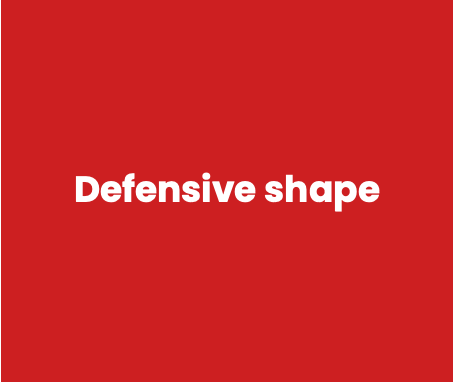What does Compactness look like
Compactness is another vital defensive principle in soccer, which refers to the idea of reducing space between players and between the lines of defense (defenders and midfielders) to limit the room the opposing team has to operate in.
Here are some examples to illustrate what it looks like when a team successfully executes the principle of compactness:
Shrinking the Play Area
Imagine Team A is playing against Team B. When Team B has the ball in their half, Team A’s players would collectively move towards the ball’s side of the pitch. This movement shrinks the play area and reduces the amount of space Team B has to operate. It also increases the chance of intercepting passes and winning the ball back.
Pressing Triggers
Compactness is also relevant when implementing pressing triggers. For example, if a team decides to press when the ball is played to the opposing team’s full-back, they need to do so in a compact manner. This means the closest player pressures the full-back, other players move up to mark potential passing options, and the defensive line moves higher up the pitch to reduce space between lines. This compact press can force the opposing player into a mistake or limit their passing options.
Defending Deep
When a team is defending deep in their own half, perhaps when protecting a lead, they need to be particularly compact. This involves keeping the lines of defence close to each other and ensuring that players remain close to their teammates. This compact shape can make it very difficult for the opposition to find spaces in and around the penalty area.
Vertical Compactness
This refers to the spaces between the lines (defence, midfield, attack) of a team. In a compact team, when the defenders drop back towards their own goal, the midfielders and attackers should also move back in unison. This shortens the distances between the lines and makes it harder for the opposing team to play through them. For instance, if the opposing team tries to play a through ball, a compact formation would make it harder to find gaps to exploit.
Horizontal Compactness
Similar to vertical compactness, but in the horizontal plane, players on the far side of the field move towards the ball’s side, reducing the width of the play. This limits the opposing team’s ability to switch play or find a teammate in open space on the other side of the field.
Technical Skills
To effectively implement Compactness, players must possess the following technical skills:
Tackling: Players should be proficient in standing tackles, slide tackles, and block tackles to win the ball back quickly and efficiently.
Positioning: Understanding and maintaining the correct defensive position is crucial for effective Concentration.
Intercepting: Anticipating passes and making interceptions can break down the attacking team’s rhythm and limit their progress.
Clearing: Players should have the ability to clear the ball out of danger areas and reset the defensive line.
Communication
Effective communication and teamwork are essential for successfully implementing Compactness. Players should:
Communicate defensive roles and responsibilities to each other.
Provide constant support and cover for teammates.
Employ non-verbal communication, such as signalling or pointing, to convey information quickly and effectively.
Maintain a strong work ethic and collective effort to execute the Defensive Principle of Concentration.
Tactical knowledge players need
To apply Compactness effectively, players must develop a strong understanding of the following tactical concepts:

Defensive shape:
The team must maintain a compact and well-organized defensive shape to limit space and restrict the attacking team’s progress.

Pressure on the ball:
Pressuring the ball carrier can force them into making mistakes or backward/sideways passes, allowing the team to regain possession.

Covering:
Players must provide support and cover for each other to prevent gaps from opening up in the defence.

Transition play: Transition play: Understanding when to transition from defence to attack and vice versa is crucial for effective implementation of Concentration.